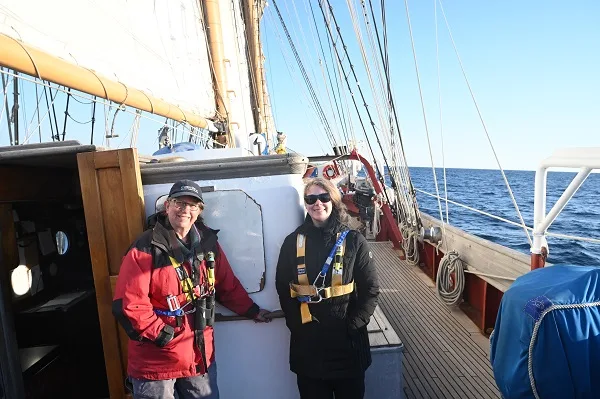Programs Blog
Discussing the Sights and Sounds of North Atlantic Right Whales

Discussing the Sights and Sounds of North Atlantic Right Whales
April 25, 2023
Dr. Craig Marin, Associate Professor of Marine Environmental History
https://sea.edu/wp-content/uploads/2023/04/Amy-and-Lindsey.jpg
The SEA Sailing Symposium continued with another set of presentations as the crew of the SSV Corwith Cramer worked the vessel north of Cape Hatteras, hitching a ride in the Gulf Stream. With a stiff breeze running counter to the current, conditions were a little bumpy in the morning, so we paused our schedule of tows and hydrophone deployments and appreciated a more settled sea state for our afternoon presentations focused on NARW visual and acoustic sighting techniques and challenges facing this critically endangered marine mammal.
New England Aquarium: Amy Knowlton, Senior Scientist for the Kraus Marine Mammal Conservation Program:
Amy Knowlton spoke to our quarterdeck audience about her career path that led her to work on the New England Aquarium’s right whale monitoring and conservation programs. She made it very clear that her experience with oceangoing research as a student for SEA was a key element in both propelling her career in marine mammal conservation work and qualifying her for the Aquarium’s program-she was recognized for the unique set of skills that SEA’s semester-long programs build in participants.
Amy went on to describe the nature of her right whale observation work, the partnerships needed to track whales (with a nod to the work that Lindsey Transue does with acoustic monitoring), and the challenges of fully understanding right whale behavior, past and present, and determining the conditions that would allow them to thrive and multiply. Amy concluded her talk with a description of the cooperative work that has been done with the fishing community to avoid the devastating impacts of whale entanglements in fishing gear. In the recording of her talk you will be able to see an example of fishing lines designed with “weak links” spaced strategically to try to avoid permanent entanglements. She also referenced “ropeless” technology that could avoid the danger of entanglement altogether.
NOAA NEFSC Passive Acoustics Research Group: Lindsey Transue, Acoustician:
Our second talk of the day was delivered by Lindsey Transue. Lindsey began with an explanation of how effective underwater passive acoustics (listening) monitoring is for determining the presence and activities of marine life. Such monitoring work is noninvasive, not weather dependent, and, with the right technology, can be done over long periods of time. In the recording of her talk, you can learn about the variety of ways that the marine soundscape is recorded. In fact, the amount of data collected could be overwhelming without the use of computer technology that can process the data and offer preliminary identifications that can then be verified by acousticians like Lindsey.
Lindsey also described how, as someone who grew up in Knoxville, TN, she eventually ended up studying marine animals and doing acoustics work. Similar to the story that Jesse told, her determination and patience with a circuitous path allowed her to pursue this passion and do this work she finds so rewarding. Now, right whales are a focus of her work, and she processes the data collected in regions frequented by this and other marine mammals to confirm, usually through the characteristic “upcall” of right whales, their presence over time in monitored areas. This work has allowed greater insight into right whale behavior and patterns of migration.
You can learn more about the work that the New England Aquarium and NEFSC Passive Acoustics Research Group do by watching their full presentations.
Full presentations to be uploaded upon voyage completion.Craig MarinAssociate Professor of Marine Environmental History
https://sea.edu/wp-content/uploads/2023/04/Amy_Alumna_Helm.jpg
Recent Posts from the Ships
- Ocean Classroom 2024-A collaborative high school program with Proctor Academy
- Collaborations and Long-term Commitments: SEA’s Caribbean Reef Program Sets a Course for Coastal Programs that Compliment Shipboard Experiences.
- Sea Education Association students prepare for life underway using state of the art nautical simulation from Wartsila Corporation.
- SEA Writer 2022, Magazines From the Summer SEA Quest Students
- Technology@SEA: Upgrades Allow Insight into Ocean Depths
Programs
- Gap Year
- Ocean Exploration
- High School
- Science at SEA
- SEA Expedition
- SEAScape
- Pre-College
- Proctor Ocean Classroom
- Protecting the Phoenix Islands
- SPICE
- Stanford@SEA
- Undergraduate
- Climate and Society
- Climate Change and Coastal Resilience
- Coral Reef Conservation
- Marine Biodiversity and Conservation
- MBL
- Ocean Exploration: Plastics
- Ocean Policy: Marine Protected Areas
- Oceans and Climate
- Pacific Reef Expedition
- The Global Ocean: Hawai'i
- The Global Ocean: New Zealand